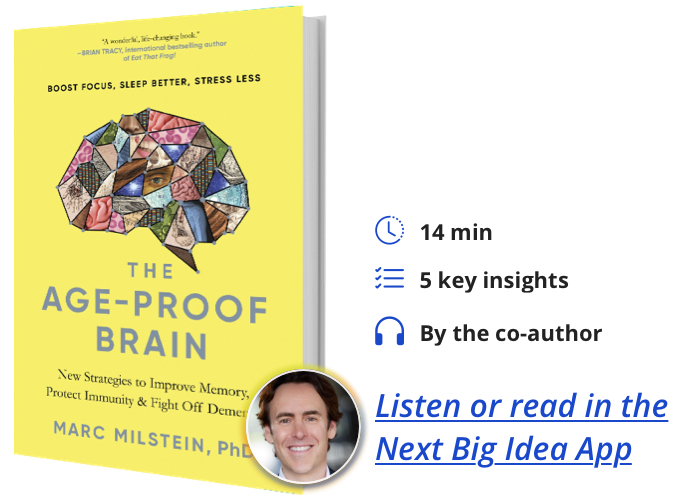Dr. Marc Milstein is a scientist, speaker and researcher who specializes in brain health and lowering risks for dementia. Dr. Milstein earned both his Ph.D. in Biological Chemistry and his Bachelor of Science in Molecular, Cellular, and Developmental Biology from UCLA. Dr. Milstein has conducted research on topics including genetics, cancer biology, neuroscience, and infectious disease.
Below, Marc shares 5 key insights from his new book, The Age-Proof Brain: New Strategies to Improve Memory, Protect Immunity, and Fight Off Dementia. Listen to the audio version—read by Marc himself—in the Next Big Idea App.
1. Wash your brain.
A crucial part of having an age-proof brain is keeping it clean. The cleanliness of your brain can determine how old your brain is. Your brain can be older or younger than your actual age, and keeping your brain more youthful is crucial to lowering the risk of dementia and optimizing day-to-day brain health. Similar to more productivity in a clean apartment or home, your brain is more efficient and healthier when it’s clean. So how do you clean your brain?
Tonight, when you go to sleep, your brain will shrink down to about 60 percent of its current size. The idea of your brain shrinking while you’re asleep may sound like a horror movie, but it’s really happening.
Your three-pound brain creates about five pounds of trash, waste, and toxins a year from the byproducts of chemical reactions that take place in your brain each day. Think of your brain like a sponge; you need to squeeze out all the waste that builds up. Every night while you’re sleeping, you squeeze that waste out into the empty space that your brain has now created because your brain is now smaller. Fluid then comes up from your spinal cord and washes all that trash away. Every single night while you sleep, you give yourself a brain wash. If you wake up and you didn’t get a good night’s sleep, with that fuzzy foggy feeling, in part, is the trash left in the brain.
Over time, that debris can build up and do severe damage. It’s not just the number of hours of sleep that you’re getting either, it’s how effective those hours are so you can get a good brainwash. Effective sleep is what keeps your brain clean and youthful.
2. Put out the fire in your gut that can spread to your brain.
Have you ever been to an aquarium and watched bottom feeders gobbling up the trash at the bottom of the tank? Microglia are these amazing little guys that similarly gobble up the trash in your brain for you. The problem, though, is when your microglia get confused and, instead of gobbling up the waste, they eat healthy brain cells. That’s when devastation to memory can occur. We know that brains can age when our immune system incorrectly attacks the brain, so why do these microglia attack? This happens when the immune system causes inflammation to occur that spreads to the brain, confusing the microglia.
“There are some foods that help put the fire of inflammation out in the gut and some foods that stoke the flames.”
Think of inflammation like a fire. How do we reduce inflammation in the body that can spread to the brain? Part of the answer is our food. There are some foods that help put the fire of inflammation out in the gut and some foods that stoke the flames.
Which foods would we want to minimize? The answer is summed up through an exhibit in the Science Museum in Chicago. In the museum, you will find a Twinkie that was unwrapped about 10 years ago. It still looks great, even delicious. It looks like it would have the perfect taste right now, even though it was unwrapped 10 years ago. These foods that never spoil are the ones to avoid; the foods filled with additives, preservatives or ultra-processed ingredients. These ingredients can cause inflammation that can spread from the gut to the brain, causing damage and aging
How do you know if your food has this stuff in it? Next time you eat something, just take a look at the packaging. If it looks like a chemistry experiment gone wrong, or you can’t pronounce any of the ingredients, minimize those foods. A great place to start is to focus on eating foods that will spoil eventually.
3. Learn new things to cross-train your brain.
Your brain has 80 billion brain cells, give or take a billion. In between those 80 billion brain cells, you have a hundred trillion connections. You have more connections in your brain right now than stars in our galaxy. Those hundred and trillion connections are your thoughts, your feelings, how you move, your memories. As we get older, we can lose those connections.
Think of your brain like a bank account. When you put deposits in, you don’t notice the withdrawals as much. The same is true for your brain cell connections. When you learn new things, you make new connections, and it can make it so that we don’t notice the loss connections as much. What should you be learning? Studies suggest that those apps and brain games make you better at those games, but it doesn’t seem to carry over to day-to-day memory.
Instead, what really seems to be helpful is picking something outside of your field of expertise, something you don’t do every day, and doing it a couple times a week. Consider taking up a a foreign language, a musical instrument, a new sport, or painting. It doesn’t seem to matter what it is as long as it’s new information. If you’re learning some brain science right now, you’re doing one of the best things you can do for your brain.
“When you learn new things, you make new connections, and it can make it so that we don’t notice the loss connections as much.”
Variation is also a great brain trainer. Think of your brain a bit like your body. You wouldn’t want to go to the gym and just do forearm workouts. Just as you want a full body workout, you want a full brain workout, which comes from a variety of activities that work out different parts of your brain.
4. Be a super-ager.
Super-agers are people in their 70s, 80s, 90s, and 100s that have the memory of someone decades younger. In some cases, some super-agers have a memory capacity of a 25-year-old. There are a couple of secrets to being a super-ager, but one is to take care of what is happening outside of your brain.
There are some specific, often-overlooked, underlying conditions that play a big role in the health of your brain. One example is untreated diabetes. Untreated diabetes raises the risk of Alzheimer’s by a staggering 65 percent. Untreated diabetes can make it harder for your brain to clean up the waste that forms in the brain. If the diabetes is treated, there’s evidence that the risk of Alzheimer’s can be brought down significantly. In some cases, that risk can even fall below the risk rate of the general population.
Fifty percent of our population either has diabetes or pre-diabetes, and one in three people in the United States has insulin resistance. Many people are not aware they have this condition and it raises the risk of developing diabetes. In fact, a recent study found that insulin resistance doubles the risk of developing major depressive disorder, even for someone who has never experienced depression previously.
What we are realizing is that part of what is driving dementia, Alzheimer’s, and day-to-day mental health issues is untreated diabetes. Through a series of simple blood tests done at your doctor’s office, you can inform yourself and empower yourself to take action. Through the knowledge of how your own body works, you can significantly lower the risk of dementia and protect your brain. By being on top of your physical health, you can leverage aspects of your mental health with treatments that will protect your brain today, tomorrow, and years down the road.
5. Give it an extra 10 seconds.
Have you ever had that experience where you go to the refrigerator and you ask yourself, “What am I doing here? What did I want in the refrigerator?” Have you ever just met someone and tell yourself, “I’m going to remember their name,” and then it quickly disappears. These types of memory issues are common and can be normal, albeit annoying. This type of memory has to do with the hippocampus, which is the part of the brain responsible for remembering those things that we tend to forget.
“If we’re not fully focused on what we’re trying to learn or remember, our brain figures it is probably not that important and throws the information away.”
The hippocampus is like the waiting room of your brain. Anything you learn or experience goes there and waits there for about seven to ten seconds. The information is just sitting in this waiting room. In that seven to ten seconds, other parts of your brain decide whether or not this information is worth keeping. If it’s worth it, the information leaves the hippocampus and is transferred to long-term memory storage. If it’s not worth it, the information is thrown away.
The next time you’re standing at the refrigerator, ask yourself, what were you doing in the last seven to ten seconds? Did you get a text, a tweet, a Facebook post, a phone call? We live in a world where we often don’t spend two seconds remembering where we parked our car or put our keys. We’re continually onto the next thing while simultaneously multitasking. We’re often on two, three screens at the same time. If we’re not fully focused on what we’re trying to learn or remember, our brain figures it is probably not that important and throws the information away.
Here is a silly tip rooted in brain science. The next time you want to remember someone’s name and you don’t want it to disappear, right after they tell you their name, imagine writing their name on their forehead. Why does that silly trick work? It takes a few extra seconds and tells your brain that this information must be worth it. It sends the information from the hippocampus, the waiting room, to long-term memory storage. Sometimes a few extra seconds can save a lot of time in remembering key information.
To listen to the audio version read by author Marc Milstein, download the Next Big Idea App today:






























